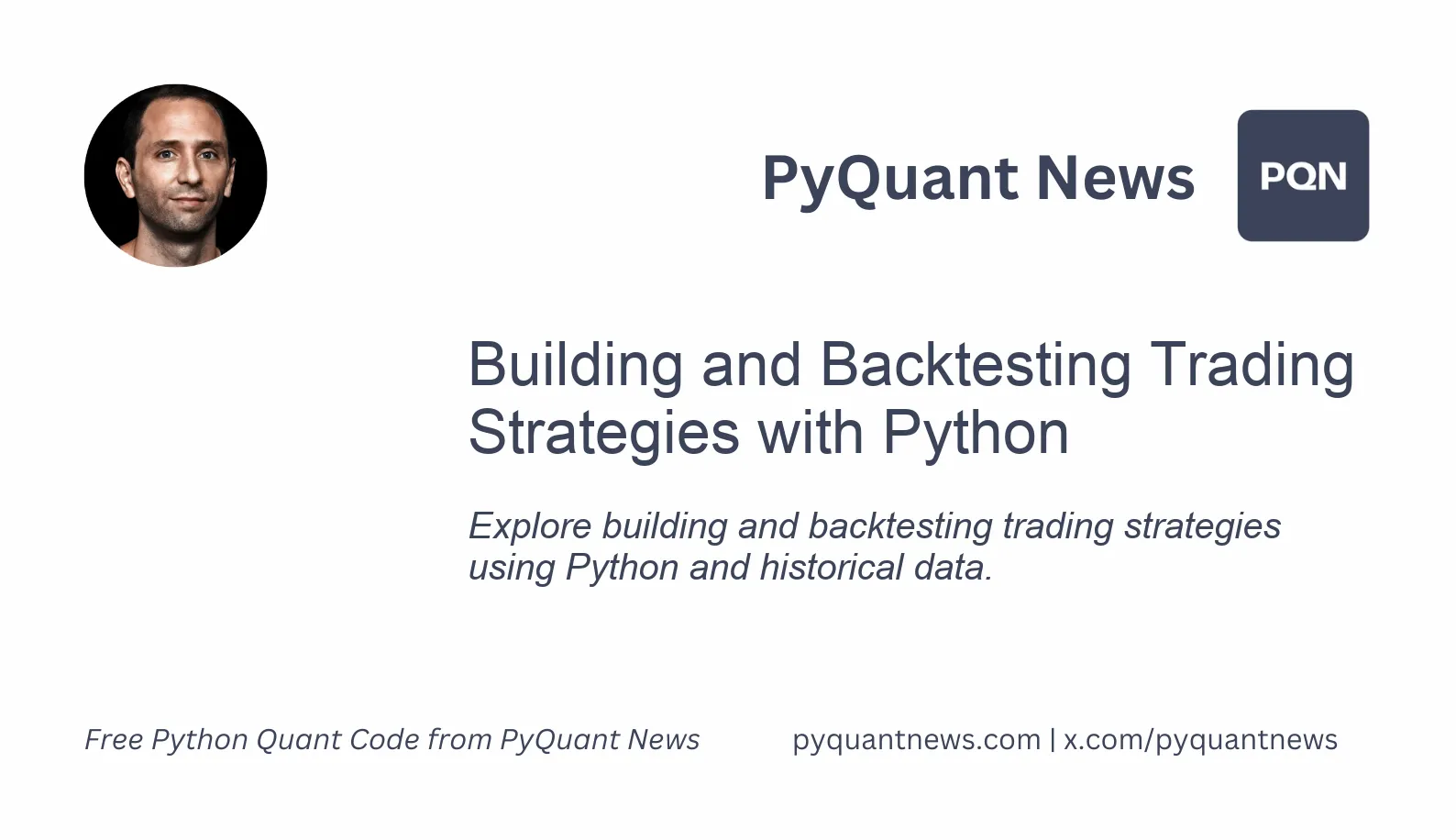Building and Backtesting Trading Strategies with Python






Building and Backtesting Trading Strategies with Python
In today's fast-moving financial world, having robust trading strategies is vital for successful investments. Thanks to technology, traders can now create, test, and refine their strategies effortlessly using powerful programming languages like Python. This guide will walk you through the process of building and backtesting trading strategies using Python and historical market data, offering a clear roadmap for both newcomers and seasoned traders.
Introduction: The Evolution of Trading Strategies
Trading has come a long way from the days of ticker tapes and manual charts. Algorithmic trading now dominates the markets, using computer programs to execute trades based on predefined strategies. Python has emerged as a favorite tool for traders, thanks to its versatility and extensive library support, enabling the efficient use of data and automation.
Why Use Python?
Python stands out for its simplicity and readability, making it accessible even to those without a deep programming background. Its rich ecosystem includes libraries like Pandas, NumPy, Matplotlib, and SciPy, which are indispensable for data manipulation, statistical analysis, and visualization. Specialized financial libraries such as QuantLib, TA-Lib, and Zipline provide a comprehensive toolkit for developing and backtesting trading strategies.
Key Concepts in Trading Strategy Development
Before jumping into the technical details, it's important to grasp some basic concepts:
- Alpha Generation: Crafting strategies that outperform the market.
- Backtesting: Testing a trading strategy on historical data to assess its performance.
- Risk Management: Employing techniques to minimize potential losses.
- Optimization: Fine-tuning strategy parameters to maximize returns.
Risk Management
Risk management includes setting stop-loss levels, position sizing, and diversifying trades to minimize potential losses. It's a vital aspect that ensures the durability and stability of trading strategies.
Step-by-Step Guide to Building and Backtesting a Trading Strategy in Python
Step 1: Define Your Trading Strategy
Start by clearly defining your objectives and setting specific rules for trade execution. For example, implement a simple moving average crossover strategy, where you buy when a short-term moving average crosses above a long-term moving average and sell when it crosses below.
Step 2: Gather Historical Market Data
Access to high-quality historical market data is crucial for effective backtesting. Platforms like Yahoo Finance, Alpha Vantage, and Quandl provide APIs to fetch historical stock prices. Verify data quality and accuracy by cross-referencing multiple sources if possible.
import yfinance as yf
ticker = "AAPL"
start_date = "2015-01-01"
end_date = "2020-01-01"
data = yf.download(ticker, start=start_date, end=end_date)
print(data.head())
Step 3: Perform Data Preprocessing
After obtaining the data, preprocess it by handling missing values, normalizing data, and creating necessary indicators. For a moving average crossover strategy, calculate the short-term and long-term moving averages:
# Calculate the 50-day simple moving average
data['SMA_50'] = data['Close'].rolling(window=50).mean()
# Calculate the 200-day simple moving average
data['SMA_200'] = data['Close'].rolling(window=200).mean()
Step 4: Implement the Trading Strategy
With indicators in place, implement the trading logic. The following code illustrates a simple moving average crossover strategy:
import numpy as np
# Initialize the 'Signal' column with zeros
data['Signal'] = 0
# Generate signals: 1 for buy, 0 for sell
data['Signal'][50:] = np.where(data['SMA_50'][50:] > data['SMA_200'][50:], 1, 0)
# Calculate the positions: difference in signals
data['Position'] = data['Signal'].diff()
Step 5: Backtest the Strategy
Backtesting lets you simulate the strategy on historical data to evaluate its performance. Key metrics include total returns, volatility, and the Sharpe ratio. Here's a basic backtesting framework:
import pandas as pd
initial_capital = 100000
positions = pd.DataFrame(index=data.index).fillna(0)
positions['AAPL'] = 100 * data['Signal'] # 100 shares per signal
portfolio = positions.multiply(data['Adj Close'], axis=0)
pos_diff = positions.diff()
portfolio['holdings'] = (positions.multiply(data['Adj Close'], axis=0)).sum(axis=1)
portfolio['cash'] = initial_capital - (pos_diff.multiply(data['Adj Close'], axis=0)).sum(axis=1).cumsum()
portfolio['total'] = portfolio['cash'] + portfolio['holdings']
portfolio['returns'] = portfolio['total'].pct_change()
print(portfolio)
Step 6: Evaluate the Strategy
After backtesting, evaluate the strategy's performance using metrics like total returns, volatility, and the Sharpe ratio. This helps understand the strategy's effectiveness and robustness. Use libraries like Pyfolio to generate detailed performance reports:
import pyfolio as pf
returns = portfolio['returns']
pf.create_full_tear_sheet(returns)
Advanced Techniques: Machine Learning and Optimization
As you gain experience, explore advanced techniques like machine learning for predictive modeling and genetic algorithms for optimizing strategy parameters. Libraries such as Scikit-learn and TensorFlow enable sophisticated modeling, while tools like DEAP facilitate evolutionary algorithms.
For instance, a trader might use a Random Forest classifier to predict stock price movements based on historical data and various financial indicators.
Resources to Deepen Your Knowledge
Books
- "Python for Finance" by Yves Hilpisch: This comprehensive guide covers basic financial concepts to advanced quantitative analysis using Python.
- "Algorithmic Trading: Winning Strategies and Their Rationale" by Ernest P. Chan: An insightful read that delves into various algorithmic trading strategies and their practical implementation.
Online Courses
- "Machine Learning for Trading" by Georgia Tech on Coursera: This course covers the application of machine learning techniques to trading.
- "Python for Financial Analysis and Algorithmic Trading" on Udemy: A practical course that teaches Python programming, financial analysis, and algorithmic trading strategies.
Websites and Blogs
- QuantStart: Offers in-depth tutorials on topics such as portfolio optimization, backtesting frameworks, and machine learning applications in trading.
- Kaggle: Engage with a community of data scientists and participate in competitions that often focus on financial data analysis.
Research Papers
Explore the Journal of Financial Economics and other academic journals for cutting-edge research on trading strategies and market analysis.
Forums and Communities
- QuantConnect: A community-driven platform where you can develop, backtest, and deploy trading algorithms.
- Stack Overflow: A go-to resource for troubleshooting coding issues and sharing knowledge with fellow developers.
Conclusion
Building and backtesting trading strategies using Python and historical market data is a powerful way to gain an edge in the financial markets. Leveraging Python's extensive libraries and tools allows traders to systematically develop, test, and refine their strategies to enhance performance. Whether you're new to trading or a seasoned professional, mastering algorithmic trading with Python offers endless opportunities for innovation and growth in the financial markets.